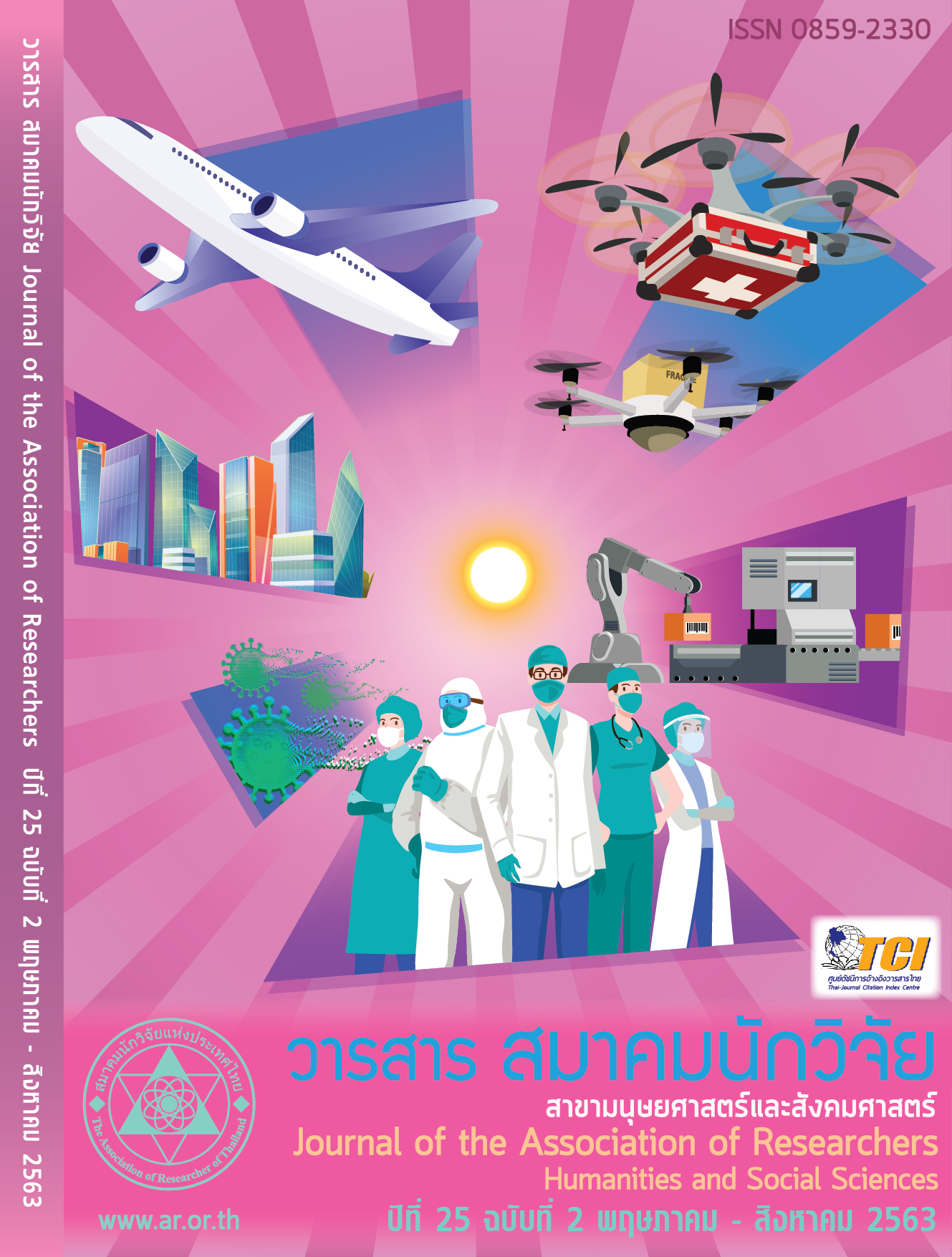The Effective Factors of the Perception on Information Technology Laws of People in Nakhon Ratchasima Province
Main Article Content
Abstract
The purpose of this research was to study components of the factors affecting the perception of information technology laws of people in Nakhon Ratchasima province. The sampling group consisted of 400 populations and used a stratified sampling method to divide the population of each district. The research tool was a set of questionnaires. The factor analysis used statistically the confirmatory factor analysis, the Oblique Rotation by Varimax Method, the Maximum Likelihood Estimation, and the Model Validity. By using the Kaiser-Meyer-Olkin (KMO) test, the result of this research is 0.939, and Bartlett’s Test of Sphericity has a statistical significance at 0.000. The results show the data relationship enabling to analysis of the proposed factors of this research. The analyzed results are composed of 5 following compositions: 1) the perception of data input and publication, 2) the perception of data transmission and retention, 3) the perception of data edition and discussion, 4) the perception of product advertisement and the monarchy dishonor, and 5) the perception of data modification and transfer. The analysis model of the Structural Equation Model according to the research hypothesis shows the consistency of empirical data. And the measurement of the effective factors of the perception on information technology laws of people in Nakhon Ratchasima shows significantly construct validity (ꭓ2=276.377, ꭓ2/dƒ=1.84, P-value = 0.000,RMSEA =0.017,CFI =0.999,SRMR =0.073andTLI = 0.993)
Article Details
บทความที่ปรากฏในวารสารนี้ เป็นความรับผิดชอบของผู้เขียน ซึ่งสมาคมนักวิจัยไม่จำเป็นต้องเห็นด้วยเสมอไป การนำเสนอผลงานวิจัยและบทความในวารสารนี้ไปเผยแพร่สามารถกระทำได้ โดยระบุแหล่งอ้างอิงจาก "วารสารสมาคมนักวิจัย"
References
ครรชิต มาลัยวงศ์. (2540). ทัศนะไอที. กรุงเทพมหานคร: สำนักงานพัฒนาวิทยาศาสตร์และเทคโนโลยีแห่งชาติ.
ณัฎฐพันธ์ เขจรนันทน์ และไพบูลย์ เกียรติโกมล. (2545). ระบบสารสนเทศเพื่อการตัดสินใจ. กรุงเทพมหานคร: ส. เอเชียเพรส.
รังสรรค์ วงษ์บุญหนัก. (2559). การวิเคราะห์กฎหมายที่เกี่ยวกับเทคโนโลยีสารสนเทศและการสื่อสารในกรณ์การโฆษณาที่ฝ่าฝืนกฎหมายผลิตภัณฑ์สุขภาพ. วารสารเภสัชกรรมไทย, 8(1), 217-227.
วิภาวดี ยุติธรรม. (2556). ปัญหาเกี่ยวกับการคุ้มครองข้อมูลส่วนบุคคลของผู้เข้ารับการรักษาพยาบาล. วารสารวิชาการ มหาวิทยาลัยราชภัฎพระนคร, 4(2), 71-80.
สายฝน เป้าพะเนา. (2555). การศึกษาสมรรถนะการใช้เทคโนโลยีสารสนเทศและการสื่อสารเพื่อการเรียนรู้ของนักศึกษาระดับปริญญาตรีมหาวิทยาลัยเทคโนโลยีราชมงคลรัตนโกสินทร์ วิทยาเขตวังไกลกังวล. Veridian E-Journal, SU, 5(1),541-561.
สุรัสวดี แสนสุข และ พลสิทธิ์ จิระสันติมโน. (2560). ข้อสังเกตเบื้องต้นเกี่ยวกับหมิ่นประมาทและดูหมิ่นในกฎหมายอาญา. วารสารมนุษยศาตร์และสังคมศาสตร์ มหาวิทยาลัยราชภัฎอุบลราชธานี, 8(ฉบับพิเศษ), 68-94.
องอาจ เทียนหิรัญ. (2546). อาชญากรรมทางคอมพิวเตอร์: การกำหนดฐานความผิดทางอาญาสำหรับการกระทำต่อคอมพิวเตอร์. นิติศาสตร์มหาบัณฑิต คณะนิติศาสตร์ มหาวิทยาลัยธรรมศาสตร์.
อัครเดช มณีภาค. (2553). ปัญหาทางกฎหมายพระราชบัญญัติว่าด้วยธุรกรรมทางอิเล็คทรอนิกส์ พ.ศ. 2544 ในการคุ้มครองข้อมูลส่วนบุคคลที่เกี่ยวข้องกับธุรกรรมทางอิเล็คทรอนิกส์. วารสารจันทรเกษมสาร, 16(31), 127-145.
อัญชลี วรถาวรวิวัฒน์. (2549). เกร็ดความรู้ Internet Tips กฎหมายเทคโนโลยีสารสนเทศ. วารสารวิชาการเทคโนโลยีอุตสาหกรรม, 2(ฉบับพิเศษ), 117-122.
Andrew V. B., and Kimberly R. H., (2007). Cyberbullying: What School Administrators (and Parents) Can Do. The Clearing House, 81(1), 8-12.
Diamantopoulos, A. &Siguaw, A. D. (2000). Introducing LISREL: A guide for the uninitiated. London: Sage Publications.
Garrison, K.C. ,&Magoon, R.(1972). Educational psychology. Ohio: Charles E. Morrill Publishing century-crofts.
Hair J. F., Anderson, R. E., Tatham, R. L., & Black, W. C. (1998). Multivariable data analysis (5th ed.). Upper Saddle River, NJ: Prentice-Hall.
Join O. H. (2011). Anti-Cyber Bullying Statutes: Threat to Student Free Speech. Cleveland State Law Review, 59(85), 88-89
Kaplan, D. (2000). Structural equation modeling. California: Sage Publications.
Kline, R. B. (1998). Principles & Practice of Structural equation modeling. New York: The Guilford Press.
Schiffman, L. G.,&Kanuk, L.L.(2000).Consumer Behavior (7thed.). Upper Saddle River, NJ: Prentice-Hall.
Zorkoezy, P. (1984). Information Technology: An introduction. New York: Van Nostrand Reinhold.
Kajonnan, N., & Kiattikomol, P. (2002). Decision information system. Bangkok: S. Asia Press.[in Thai].
Maneepak, A. (2010). Legal problems of the electronic business transaction Act B.E. 2554 in protecting personal information relating to an electronic transactions. ChandrakasemRajabhat University Journal, 16(31), 127-145.[in Thai].
Maraiwong, K. (1997). Perspective IT. Bangkok: National Science and Technology Development Agency.[in Thai].
Paophanao, S. (2012). The study of information technology and communication competencies for learning of undergraduate students in Rajamagala university of technology RattanakosinWangkraikangwon Campus. Veridian E-Journal, SU, 5(1),541-561.[in Thai].
Saensuk, S.,&Chirasantimano, P. (2017). Primary remarks on the offence of defamation and insult in the criminal code of Thailand. Humanities and Social Sciences Journal, UbonRatchathaniRajabhat University, 8(Special Issue), 68-94.[in Thai].
Theangirun, A. (2003). Computer crime: definition of crime. Master of Laws Program, Faculty of low, Thammasat University.[in Thai].
Thongraweewong, K. (2012). Legal measure for protecting the right to privacy: A study of the invasion of privacy through the use of social network websites. Atheist Journals, 18(2), 39-51.[in Thai].
Voratavarawiwat, A. (2006). Internet trip information technology law. The Journal of Industrial Technology, 2 (Special Issue), 117-122.[in Thai].
Wongboonnak, R. (2016). Analysis of laws regarding information and communication technology on the advertisings violating health products laws. The Journal of Pharmacy Practice, 8(1), 217-227.[in Thai].
Yutitam, V. (2013). Problems relating to the protection of personal data in the medical treatment of patients. Academic Journal PhranakhonRajabhat University, 4(2), 71-ผ80.[in Thai].


